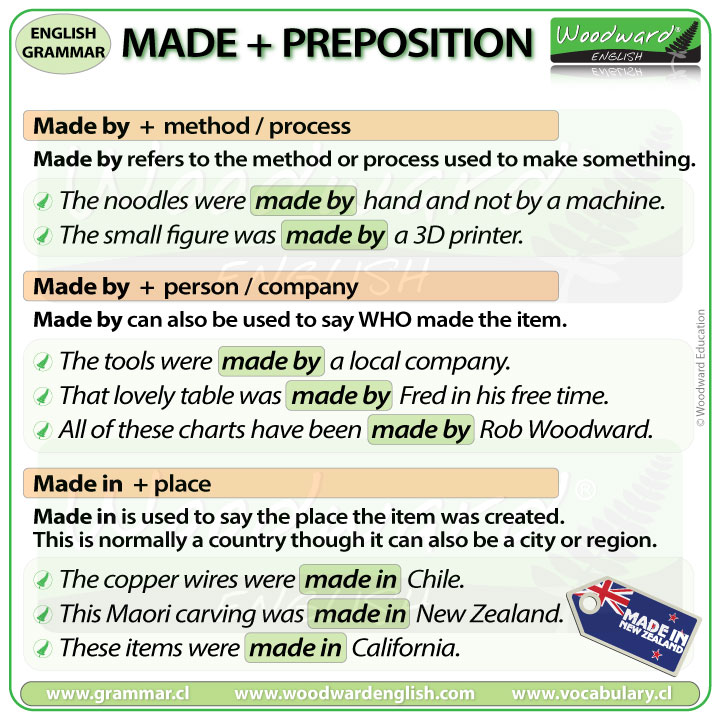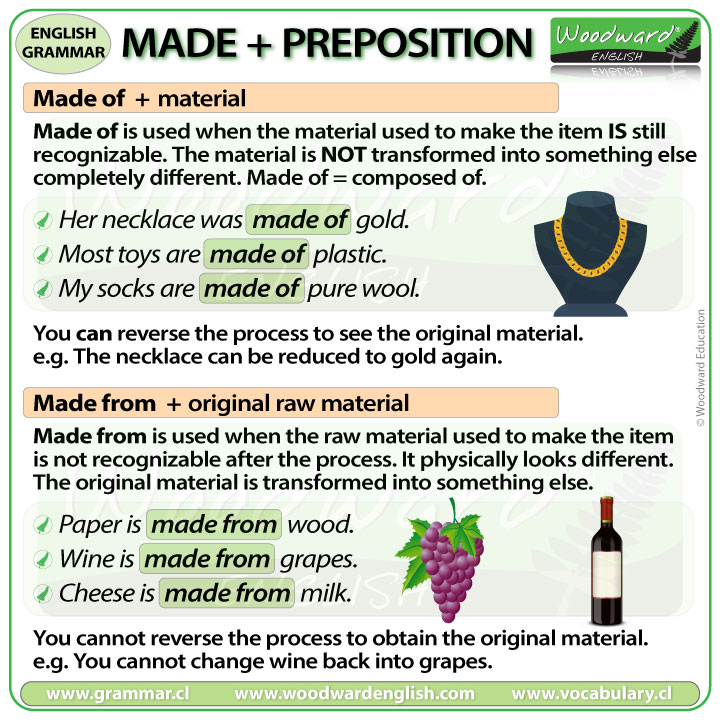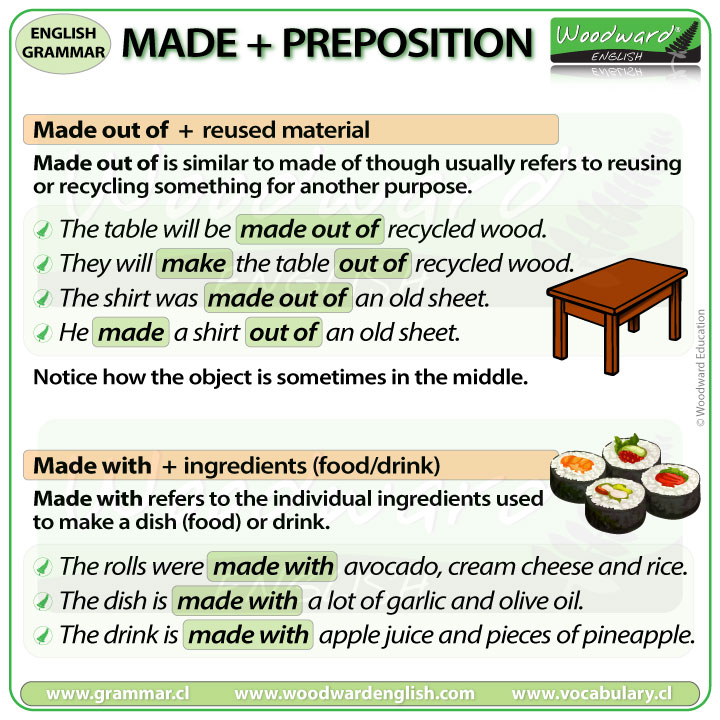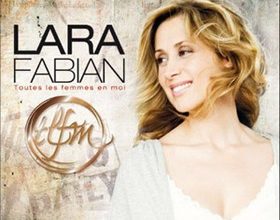Эти выражения похожи, но их точное значение зависит от правильного употребления предлогов. Разбираемся, в чем основное различие между made of и made from.
- В чем разница между MADE OF и MADE FROM?
- Примеры употребления MADE OF и MADE FROM
- Прогресс урока
- MADE OUT OF
- MADE WITH
- My Lingua Academy
- Made + preposition – made of, made from, made by
- Made by + method / process
- Made by + person / company
- Made in + place
- Made from + origin (how something is manufactured) substance?
- Made of + material
- Made out of + reused material
- Made with + ingredients (food/drink)
- В чем разница между TO DO и TO MAKE?
- Когда использовать TO DO?
- To DO — выполнять задание
- To DO — абстрактное действие
- To DO — замена других глаголов
- Выражения с DO
- To MAKE — обозначение места или материала производства
- To MAKE — создание чего-либо
- To MAKE — побуждение к действию
- To MAKE — планирование
- Выражения с MAKE
В чем разница между MADE OF и MADE FROM?
Made of используется, когда материал, из которого состоит предмет, не меняется в процессе его создания
Made from используется, когда материал меняет свою форму и теряет основные свойства в процессе производства
Примеры употребления MADE OF и MADE FROM
Теперь попробуйте самостоятельно сделать выбор между ними
Прогресс урока
Разница: MADE OF vs MADE FROM
Прогресс страницы 0%, попробуйте завершить ее, прежде чем идти дальше!
Hello, English learners! Don’t you agree that sometimes, it can be pretty hard to tell whether something is “made of” or “made from”, “made with”, or even “made out from”. As a matter of fact, things couldn’t be more straightforward. Let’s look at the explanation:
We use MADE FROM when we talk about how something is produced. The material it has been made from cannot be seen because it has been changed.
I am a fan of clothes made from natural materials.Cheese is made from milk.This cake was made from egg whites.
Something is MADE OF when its material hasn’t been significantly changed. We can still see it in the object.
This shirt is made of cotton.This ring is made of gold.That house in the woods is made of logs.
MADE OUT OF
However, when something was changed from one thing into another, we can say that it was MADE OUT OF:
Today, they make fridge parts out of recycled materials.Can you believe that her bag is made out of plastic bottles?The plates they were eating from were made out of the finest porcelain.
MADE WITH
Finally, we usually use MADE WITH to talk about the ingredients contained in foods and drinks:
The bartender made this cocktail with gin and tonic.Bread is normally made with flour and water.Mousaka is made with vegetables and minced meat.

Made of, Made from, Made out of, Made with
Do the quiz to perfect your knowledge:
Drop us a line on WhatsApp
My Lingua Academy
My Lingua Academy is an online school of English language.
We give one-on-one lessons to students of English of all ages and all levels of knowledge all around the world. With us you can prepare for written assignments and exams, attend a general or business English course, or have conversation classes with qualified English teachers who have years of experience.
Made + preposition – made of, made from, made by
What preposition do you use after MADE?
Made by or Made in?
Made from or Made of?
Made out of or Made with?
Let’s look at the difference between all of these:
Made by + method / process
Made by refers to the method or process used to make something.
- The noodles were made by hand and not by a machine.
- The small figure was made by a 3D printer
Made by + person / company
Made by can also be used to say WHO made the item. This can be a person or a company.
- The tools were made by a local company.
- That lovely table was made by Fred in his free time.
Made in + place
Made in is used to say the place the item was created. This is normally a country though can also be a city or region.
- The copper wires were made in
- The beautiful carving was made in New Zealand.
- These items were made in California.

Made from + origin (how something is manufactured) substance?
Made from is used when the raw material used to make the item is not recognizable after the process (it physically looks different). The material is transformed into something else.
- Paper is made from
- Wine is made from
- Cheese is made from
You cannot reverse the process to obtain the origin material. You cannot change wine back into grapes.
Made of + material
Made of is used when the material used to make the item is still recognizable. The material is NOT transformed into something else completely different. Made of = composed of.
- Her necklace was made of gold.
- Most toys are made of plastic.
- My socks are made of pure wool.
You can reverse the process to see the original material.
e.g. The necklace can be reduced to gold again.

Made out of + reused material
Made out of is similar to made of though usually refers to reusing or recycling something for another purpose.
- The table will be made out of recycled wood.
- They will make the table out of recycled wood.
- The shirt is made out of an old sheet.
- He made a shirt out of an old sheet.
(Notice how the object can in the middle)
Made with + ingredients (food/drink)
Made with refers to the individual ingredients used to make food or drink.
- The rolls were made with avocado, cream cheese and rice.
- The dish is made with a lot of garlic and olive oil.
- The drink is made with apple juice and pieces of pineapple.

Hello, I have a question to you- when we need to say made of and when we need to say made from.
For example: the frog that I have seen on the exhibition was made of iron and During the Pesah holiday, shops do not sell bread and other products made from flour.
Are the both sentances are right?
Both are correct. I don’t think you would say «made of flour», however you could say «made from iron».
I believe it’s usual to use ‘made of’ when we talk about materials — The table is made of wood, and the chair is made of plastic. — and ‘made from’ when we talk about ingredients — Beer is made from malt and hops.
But I don’t think this is any kind of absolute rule.
I agree with Merrit here. ‘Made of’ is for what it now is: if it’s made of iron, it’s now a (frog-shaped) piece of iron. ‘Made from’ can be used more widely for the things that went into the making: cakes are made from flour and eggs, but you wouldn’t say the cake is flour and eggs. It’s not made of flour and eggs.
Welcome to the forum, Rebekaa
My suggestion is that «of» and «from» in this context are like English prepositions in general, i.e. that one just has to learn each common usage and that trying to establish a hard and fast rule is doomed to failure.
My shoes are made of leather.
My shoes are made from cow hide.
be made from something Paper is made from wood.(Here You can’t see any wood in the paper means that wood is not appeared
be made (out) of something The shirt made of silk (Here You can see the silk and touch it in the shirt )
I agree. We can say a chair is made of wood because it is still wood. Butter is made from milk because it is no longer milk.
However, that’s an interesting point by sdgraham about cow-hide and leather. It could be that leather is the final material, ready for making shoes, while the cow-hide is the raw material from which leather is made. Is that possible?
Both «from» and «of» have some implication that the flour is a major part of the final product (bread is made from flour). A third possibility is «with» which would mean that there is some flour in the product (this fried fish is made with flour). I suspect since this is a religious restriction that not even a tiny bit of flour is allowed, and therefore it may be even more accurate to say that products made with flour are not allowed..
I guess so, but then you are drawing a distinction between cow-hide and leather, which he specifically says are synonymous.
Personally, I wouldn’t say ‘made from cow-hide’ when I meant ‘made of leather’. That would be equivalent to saying ‘my table is made from trees’. It may be factual, but it’s not the way I choose to express it.
Others have mentioned the distinction that leather is a hide which has been tanned. Another reason that these two can’t be «synonymous» is that not all leather is made from the hide of a cow.
I know there have been discussions about the difference between them before too. But I wrote a summary on how they are usually used based on different explanations and exceptions. Is it written correctly?
But is «made with» used only when talking about food?
In the sense of “made using” (making use of), “made with” makes perfect sense in all sorts of contexts. It’s an extremely common collocation.
However, in the context you’re talking about (stating the ingredients/components of something), Cambridge does say that it’s mainly used in relation to food and drink:
Made from, made of, made out of, made with
Thank you for your reply. Is the rest written correctly?
«Made of» is the simplest, and you describe this well.
«Made from» can be used with the same meaning as «made of», but this is relatively unusual. It is more commonly used to describe the component(s)/ingredient(s)/material(s) as they were before being turned into the thing. A table, for example, could be made from an oak tree, but it is made of oak (or wood), not made or an oak tree. A car might be made from 1000 components (before they were turned into a car, you could count them as individual items).
Both «made of» and «made from» refer to either all of the components/ingredients/materials or to the most important component(s)/ingredient(s)/material(s).
«Made out of» is generally similar in meaning to «made from», but tends only to be used either with the same meaning of «made of» or where the component(s)/ingredient(s)/material(s) have an earlier, recognisable form. You could, for example, say that a pair of sandals was made out of an old car tyre, but you could not say that a car was made out of 1000 components.
«Made with» tends to be used to highlight one particular component or ingredient, not necessarily the largest or most significance, although it is usually of some importance, as in this bag of popcorn that is «made with real butter»:
There is no particular reason for «made with» to be used with food, but with other things we might not be so interested in a particular component/ingredient/material.
Where did you see «made up»? Are you thinking of «made up of» or «made up from»?
Thank you! I accidentally typed «made up» instead of «made up of» and «made up from». I meant to say «made out of» can be used for both «made from», «made of», «made up of» and «made up from». I hope it’s correct. Is it?
«Made up of» is used to describe an assembly’s constituent parts (which don’t go through any transformation in the making of the assembly), and is fine when the thing only has a few parts and you are naming them all, but it doesn’t have much other use. «Made up from» is so rare that it probably isn’t worth discussing, unless you have an example of it being used.
Thank you so much. I sometimes see them used interchangeably. Perhaps learners of English should not do that. For example, «The bread is made of + ingredients and made from+ ingredients. Or Some leather shoes are made of leather (material I understand that) but I have seen «made from» in such examples. What do you think about it?
I wouldn’t use «made of» with a recipe. The shoes being made of leather is fine, but «made from» might also be used, though is a lot less common..
В чем разница между TO DO и TO MAKE?
DO рассказывает об общих действиях и задачах, MAKE — о создании чего-либо:
DO обычно описывает процесс, MAKE — результат
Например, если вы — готовите завтрак, то получается результат (приготовленное блюдо). Если вы do the shopping — делаете покупки, то вы идете в магазин, смотрите товары, выбираете — это процесс.
Когда использовать TO DO?
Когда речь идет о работе, каких-либо делах и задачах:
Когда говорится об абстрактных действиях, без конкретики:
Для замены других глаголов, если смысл фразы понятен из контекста:
To DO — выполнять задание
Используется со словами, обозначающими привычные действия, домашние обязанности, профессиональные задачи, например: , , ,
To DO — абстрактное действие
Используется, когда мы не называем конкретное действие или говорим о чем-то общем, что нельзя назвать
В этом случае DO часто используется со словами , , , etc.
To DO — замена других глаголов
Характерно для разговорного английского: вместо конкретного действия мы говорим do:
Выражения с DO
Для указания, где или из чего произведен продукт:
Когда что-то сделано своими руками или приготовлено:
Когда говорим о побуждении к действию, реакции или результате:
Когда строим планы:
To MAKE — обозначение места или материала производства
Здесь все просто:
To MAKE — создание чего-либо
Используется, когда речь идет о приготовлении еды или изготовлении какого-либо предмета:
С деньгами тоже используется глагол make:
To MAKE — побуждение к действию
Часто переводится как
Сюда же относится использование MAKE для описания результата или влияния какого-то действия, предмета или события на внешний вид или душевное состояние человека:
To MAKE — планирование
Используется в сочетании с определенными существительными, обозначающими планы, решения, обещания:
Выражения с MAKE
Обновлено на
8 окт. 2021

Вопрос про Английский (американский вариант)

When you «disagree» with an answer

I’m really sorry for late reply.Your advice helps so much!!Now I got it difference of them.It was so educational.I really appreciate you.
Previous question/ Next question
Символ показывает уровень знания интересующего вас языка и вашу подготовку. Выбирая ваш уровень знания языка, вы говорите пользователям как им нужно писать, чтобы вы могли их понять.
- Мне трудно понимать даже короткие ответы на данном языке.
- Могу задавать простые вопросы и понимаю простые ответы.
- Могу формулировать все виды общих вопросов. Понимаю ответы средней длины и сложности.
- Понимаю ответы любой длины и сложности.
Что такое «подарки»?
Show your appreciation in a way that likes and stamps can’t.
By sending a gift to someone, they will be more likely to answer your questions again!

If you post a question after sending a gift to someone, your question will be displayed in a special section on that person’s feed.

У вас есть вопрос, на который нет ответа в словаре или электронном переводчике? Спросите у носителя языка!



